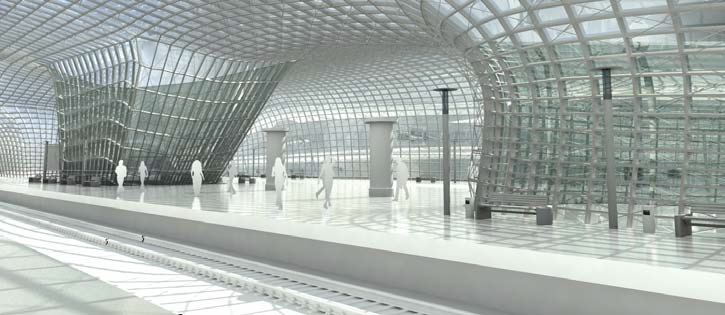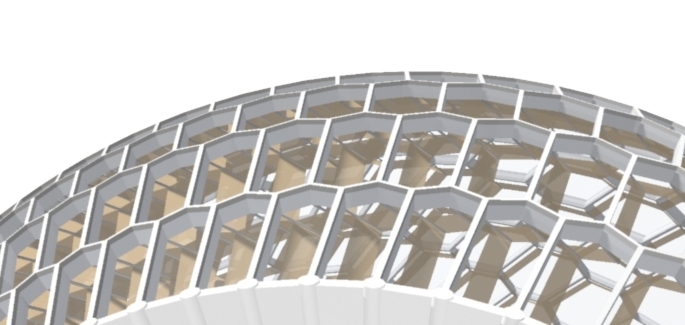Introduction
The use of freeform surfaces is gaining increasing popularity in architecture design, one reason being that curved facades are often more appealing than the commonly found planar walls. After a freeform facade has been designed, the next step is to partition the facade into small pieces, each of which will be manufactured into panels during construction. These panels may be either planar or curved, and are most frequently built with glass. However, fabrication of curved glass panels is expensive. Hence, the primary problem is to determine a good approximation to a freeform facade with planar panels, in order to reduce the manufacturing costs.
We develop new methods to generate delicately designed partitions, composed of either planar quadrilateral polygons or planar hexagonal polygons, of a given shape. We also extend our methods to generate developable panels, which themselves are not planar but can be bent from planar panels and the unit cost to manufacture such developable panels is lower than that of freeform panels. In some occasions, for example in roofing, several layers of planar panels of the same connectivity are required to integrate as a multi-layer structure. The difficulty then is to guarantee exact offsets between the layers of planar panels. Figures 1, 2 and 3 show several architecture models designed by our method. It can be seen that the partition generated by our method possesses the offset property.

Figure 1: An architecture model built with planar quadrilateral panels.
 |
 |
| 2(a) Left: An architecture model with several layers of planar hexagonal panels with exact offsets. Right: A close-up to the multi-layer structure. | |

2(b) Another architecture model with planar hexagonal panels.
Figure 2: Two architecture models with planar hexagonal panels.

Figure 3: An architecture model designed with developable panels.
Contributions
1. We introduce conical meshes and parallel meshes with planar faces and offset property.
2. Given a shape, we devise a novel approach to generating an initial partition, which is a good approximation of a target conical mesh and then get it evolved to the conical mesh by optimization.
3. We establish the correspondence between single-curved panels (developable panels) and conjugate network and utilize this correspondence to achieve single-curved paneling.
4. We establish the connection between regular triangulations and planar hexagonal meshes by Dupin duality, and further devise an algorithm for generating a planar hexagonal mesh by first computing its dual regular triangulation.
This work is in collaboration with Prof. Helmut Pottmann at the Vienna University of Technology.
Selected Publications
Y. Liu, H. Pottmann, J. Wallner, Y.L. Yang and W. Wang, Geometric modeling with conical meshes and developable surfaces. ACM Transactions on Graphics (SIGGRAPH 2006), vol. 25, no. 3, (2006), pp. 681 - 689.
H. Pottmann, Y. Liu, J. Wallner, A. Bobenko and W. Wang, Geometry of multi-layer freeform structures for architecture. ACM Transactions on Graphics (SIGGRAPH 2007), vol. 26, no. 3, (2007).
H. Pottmann, A. Schiftner, P.B. Bo, H. Schmiedhofer, W. Wang, N. Baldassini and J. Wallner, Freeform surfaces from single curved panels, ACM Transactions on Graphics (SIGGRAPH 2008), vol. 27, no. 3, (2008).
W. Wang, Y. Liu, D.-M. Yan, B. Chan, R.-T. Ling and F. Sun, Hexagonal meshes with planar faces. TR-2008-13, Technical Report, Department of Computer Science, The University of Hong Kong (2008).
For further information on this research topic, please contact Professor Wenping Wang or Dr Loretta YK Choi.
